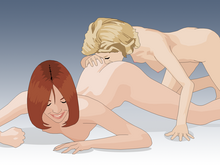Sexual practices between women: Difference between revisions
Enthusiast01 (talk | contribs) |
Enthusiast01 (talk | contribs) →Behaviors: Clarification |
||
| Line 4: | Line 4: | ||
==Behaviors== |
==Behaviors== |
||
[[File:Wiki-cunnilingus.png|thumb|left|Women engaging in [[cunnilingus]].]] |
[[File:Wiki-cunnilingus.png|thumb|left|Women engaging in [[cunnilingus]].]] |
||
Lesbian sexual activities may be of a [[Sexual intercourse|penetrative]] or [[Non-penetrative sex|non-penetrative nature]]. These behaviors include [[fingering (sexual act)|fingering]] (digital stimulation, which may or may not be penetrative), [[oral sex]] (which may or may not be penetrative), [[oral stimulation of nipples|stimulation of nipples]] or other [[erogenous zone]] |
Lesbian sexual activities may be of a [[Sexual intercourse|penetrative]] or [[Non-penetrative sex|non-penetrative nature]]. These behaviors include [[fingering (sexual act)|fingering]] (digital stimulation, which may or may not be penetrative), [[oral sex]] (which may or may not be penetrative), [[oral stimulation of nipples|stimulation of nipples]] or other [[erogenous zone]]. More rarely used is [[anal-oral sex]].<ref>{{cite journal |author=Diamant AL, Lever J, Schuster M |title=Lesbians' Sexual Activities and Efforts to Reduce Risks for Sexually Transmitted Diseases |journal=J Gay Lesbian Med Assoc. |volume=4 |issue=2 |pages=41–8 |month=Jun |year=2000 |doi=10.1023/A:1009513623365 |url=http://www.springerlink.com/content/x012016264435548/}}</ref> |
||
[[Tribadism]] (also known as "scissoring") is a common sexual practice among women.<ref name=Zimmerman/><ref name="Carroll"/><ref name="Halberstam"/><ref name="Kimmel">{{cite book|title =Lesbian, gay, bisexual, and transgender aging: research and clinical perspectives|id = 9780231136181|publisher=Jones & Bartlett Learning|year=2006|pages=303|accessdate=2010-12-19|url=http://books.google.com/books?id=Ae39o9m66hIC&pg=PA73&dq=Lesbians+and+tribadism#v=onepage&q=Lesbians%20and%20tribadism&f=false|isbn =0-231-13618-8,|author =Douglas C. Kimmel, Tara Rose, Steven David}}</ref><ref name="Greenberg">{{cite book|title =Exploring the dimensions of human sexuality|id = 9780763741488|publisher=Jones & Bartlett Learning|year=2007|pages=884|accessdate=2010-12-19|url=http://books.google.com/books?id=ZdYh_iFZvbkC&pg=PA429&dq=Lesbians+and+tribadism#v=onepage&q=Lesbians%20and%20tribadism&f=false|isbn =0-7637-4148-5,|author = Jerrold S. Greenberg, Clint E. Bruess, Sarah C. Conklin}}</ref><ref name="Peplau">{{cite book|title = Women's Sexualities: New Perspectives on Sexual Orientation and Gender (Volume 56 of Journal of Social Issues)|id = 140510080X, 9781405100809|publisher=Wiley-Blackwell|year=2002|pages=242|accessdate=2010-12-19|url=http://books.google.com/books?id=6QVVjOAKdVsC&pg=PA320&dq=Lesbians+and+tribadism#v=onepage&q=Lesbians%20and%20tribadism&f=false|author = Letitia Anne Peplau, Linda D. Garnets|isbn = 978-1-4051-0080-9}}</ref> The practice involves stimulation of the vulva which may be achieved in a number of positions, including a [[missionary position]], a [[Woman on top (sex position)|woman on top]] position, a [[doggy style]] position and others.<ref name="Rice"/> or the rubbing of the woman's vulva against her partner's thigh, stomach, buttocks, arm, or another body part.<ref name="Rice"/><ref name="Belge">Kathy Belge [http://lesbianlife.about.com/od/lesbiansex/f/Tribadism.htm What is Tribadism?], accessed December 19, 2010.</ref> It may be accompanied by actual penetration with fingers or a [[dildo]]. |
|||
[[Image:Édouard-Henri Avril (27).jpg|thumb|Late 19th century painting by [[Édouard-Henri Avril]] showing the use of a strap-on dildo]] |
[[Image:Édouard-Henri Avril (27).jpg|thumb|Late 19th century painting by [[Édouard-Henri Avril]] showing the use of a strap-on dildo]] |
||
Revision as of 10:07, 6 May 2012

Lesbian sexual practices are sexual activities where the participants are only women. The participants can be lesbian or bisexual women, though some prefer to refer to themselves as women who have sex with women and dispense with sexual identification. Romantic or sexual interpersonal relationships are often subject to sexual desire and arousal, which then leads to sexual activity for sexual release. A physical expression of intimacy depends on the context of the relationship along with social, cultural and other influences.[1]
Behaviors

Lesbian sexual activities may be of a penetrative or non-penetrative nature. These behaviors include fingering (digital stimulation, which may or may not be penetrative), oral sex (which may or may not be penetrative), stimulation of nipples or other erogenous zone. More rarely used is anal-oral sex.[2]
Tribadism (also known as "scissoring") is a common sexual practice among women.[3][4][5][6][7][8] The practice involves stimulation of the vulva which may be achieved in a number of positions, including a missionary position, a woman on top position, a doggy style position and others.[9] or the rubbing of the woman's vulva against her partner's thigh, stomach, buttocks, arm, or another body part.[9][10] It may be accompanied by actual penetration with fingers or a dildo.

For penetrative stimulation of the vagina or anus, a partner may use fingers or their tongue. For deeper penetration, a dildo, strap-on dildo or other sex toys may be used. For variety, a couple may engage in BDSM activities.[11][4] There are various sex positions for any of the aforementioned acts (penetrative and non-penetrative).[11][4]
Sex educator and feminist Shere Hite's research (while subject to methodological limitations) showed "sex as we define it is a cultural institution, not a biological one," that most women need clitoral or exterior stimulation for orgasm which can be "easy and strong, given the right stimulation" and most women reach orgasm more easily by masturbation.[1] Hite noted one of her female research subjects had written, "Sex with a woman includes: touching, kissing, smiling, looking serious, embracing, talking, digital intercourse, caressing, looking, cunnilingus, undressing, remembering later, making sounds, sometimes gently biting, sometimes crying, and breathing and sighing together."[12]
Research
In 1953, Alfred Kinsey's Sexual Behavior in the Human Female showed that, over the previous five years of sexual activity, 78% of women had orgasms in 60% to 100% of sexual encounters with other women, compared with 55% for heterosexual sex.[13] Kinsey attributed this difference to female partners knowing more about women's sexuality and how to optimize women's sexual satisfaction than male partners do.[14]
Studies by scholars such as Masters and Johnson and Marilyn Frye concluded that lesbian sexual behaviors more often have qualities associated with sexual satisfaction than their heterosexual counterparts.[7][15] Like Kinsey, scholars such as Peplau, Fingerhut and Beals (2004) and Diamond (2006) found that lesbians have orgasms more often and more easily in sexual interactions than heterosexual women do,[14] and that female partners are more likely to emphasize the emotional aspects of lovemaking.[14] Other elements of lesbian sexual encounters include more full-body sexual contact, rather than genital-focused contact, less preoccupation or anxiety about achieving orgasm, more sexual assertiveness and communication about sexual needs, longer lasting sexual encounters and greater satisfaction with the overall quality of one's sexual life.[7][15] Masters and Johnson's further concluded that vaginal penetration with dildos is rare, and that lesbians tend to do more overall genital stimulation than direct clitoral stimulation, which is also often the case for heterosexual relationships.[7]
Preferences for specific sexual practices among lesbians have also been acknowledged. There are lesbians who like anal sex and others "who cannot bear the thought of it".[16] In 1987, a non-scientific study (Munson) was conducted of more than 100 members of a lesbian social organization in Colorado. When asked what techniques they used in their last 10 sexual encounters, 100% reported kissing, sucking on breasts, and manual stimulation of the clitoris; more than 90% reported French kissing, oral sex, and fingers inserted into the vagina; and 80% reported tribadism. Lesbians in their 30s were twice as likely as other age groups to engage in anal stimulation (with a finger or dildo).[4]
Health risks

Like most sexual activity, lesbian sexual activities can carry risks of sexually transmitted diseases, such as HIV, and other pathogenic diseases.[17] When lesbian sexual activity is of a non-penetrative nature, the risk of exchange of bodily fluids is generally lower than for heterosexual sexual intercourse, and the incidence of transmission of such diseases is relatively low, though not eliminated. The use of the same sex toys by more than one person increases the risk of transmitting such diseases.
The Centers for Disease Control (CDC) reported there is little data available regarding the risk of spreading sexually transmitted diseases between women.[18] However, the CDC notes that pathogens such as metronidazole-resistant trichomoniasis, genotype-concordant HIV, human papilloma virus (HPV, which has been linked to nearly all cases of cervical cancer) and syphilis can be spread through sexual contact between women.[18] While the rates of these pathologies is unknown, one study showed 30% of lesbians and bisexual women had medical histories with sexually transmitted diseases.[19] This does not mean sexually active lesbians are exposed to higher health risks than the general population. Health Canada noted "the prevalence of all types of HPV (cancer and non-cancer-causing) in different groups of Canadian women ranges from 20%–33%" and an American university study found 60% of sexually active females were infected with HPV at some time within a three year period.[20]
are generally agreed upon by
public health officials for
women who have sex with women
to avoid sexually transmitted diseases (STDs):
Avoid contact with a partner’s menstrual blood and with any visible genital lesions. Cover sex toys that penetrate more than one person’s vagina or anus with a new condom for each person; consider using different toys for each person. Use a barrier (e.g., latex sheet, dental dam, cut-open condom, plastic wrap) during oral sex. Use latex or vinyl gloves and lubricant for any manual sex that might cause bleeding.[21]
The CDC did not recognize female-to-female transmission as a possible method of HIV infection until 1995. It is possible, though less likely, for transmission to occur in female-to-female sexual activity.[18] Though the risk is not as high as for male-to-male and male-to-female transmission, the risk is still present. HIV can be spread through body fluids, such as blood (including menstrual blood), vaginal fluid and breast milk. Transmission can also take place through oral sex if a woman has cuts or sores in her mouth, or poor oral hygiene, especially if her partner is menstruating. HIV can also be spread through the sharing of penetrative sex toys if their use results in broken skin within the vagina or anus.[22]
See also
References
- ^ a b "The Hite Reports: What do they say?". hite-research.com. Archived from the original on June 1, 2009. Retrieved November 19, 2011.
- ^ Diamant AL, Lever J, Schuster M (2000). "Lesbians' Sexual Activities and Efforts to Reduce Risks for Sexually Transmitted Diseases". J Gay Lesbian Med Assoc. 4 (2): 41–8. doi:10.1023/A:1009513623365.
{{cite journal}}: Unknown parameter|month=ignored (help)CS1 maint: multiple names: authors list (link) - ^ Cite error: The named reference
Zimmermanwas invoked but never defined (see the help page). - ^ a b c d Janell L. Carroll (2009). Sexuality Now: Embracing Diversity. Cengage Learning. p. 629. ISBN 0495602744, 9780495602743. Retrieved 2010-12-19.
{{cite book}}: Check|isbn=value: invalid character (help) - ^ Cite error: The named reference
Halberstamwas invoked but never defined (see the help page). - ^ Douglas C. Kimmel, Tara Rose, Steven David (2006). Lesbian, gay, bisexual, and transgender aging: research and clinical perspectives. Jones & Bartlett Learning. p. 303. ISBN 0-231-13618-8,. 9780231136181. Retrieved 2010-12-19.
{{cite book}}: Check|isbn=value: invalid character (help)CS1 maint: extra punctuation (link) CS1 maint: multiple names: authors list (link) - ^ a b c d Jerrold S. Greenberg, Clint E. Bruess, Sarah C. Conklin (2007). Exploring the dimensions of human sexuality. Jones & Bartlett Learning. p. 884. ISBN 0-7637-4148-5,. 9780763741488. Retrieved 2010-12-19.
{{cite book}}: Check|isbn=value: invalid character (help)CS1 maint: extra punctuation (link) CS1 maint: multiple names: authors list (link) Cite error: The named reference "Greenberg" was defined multiple times with different content (see the help page). - ^ Letitia Anne Peplau, Linda D. Garnets (2002). Women's Sexualities: New Perspectives on Sexual Orientation and Gender (Volume 56 of Journal of Social Issues). Wiley-Blackwell. p. 242. ISBN 978-1-4051-0080-9. 140510080X, 9781405100809. Retrieved 2010-12-19.
- ^ a b Cite error: The named reference
Ricewas invoked but never defined (see the help page). - ^ Kathy Belge What is Tribadism?, accessed December 19, 2010.
- ^ a b Douglas C. Kimmel, Tara Rose, Steven David (2006). Lesbian, gay, bisexual, and transgender aging: research and clinical perspectives. Jones & Bartlett Learning. p. 303. ISBN 0231136188, 9780231136181. Retrieved 2010-12-19.
{{cite book}}: Check|isbn=value: invalid character (help)CS1 maint: multiple names: authors list (link) - ^ "Lesbianism: Women's Sexual Expression Together". hite-research.com. Archived from the original on October 17, 2008. Retrieved February 3, 2012.
- ^ Kinsey, A.; Pomeroy, W.; Martin, C., & Gebhard, P. Sexual Behavior in the Human Female, Philadelphia: Saunders (1953), ISBN 978-0253334114.
- ^ a b c Psychology Applied to Modern Life: Adjustment in the 21st Century. Cengage Learning. 2011. pp. 688 pages. ISBN 1111186634, 9781111186630. Retrieved January 5, 2012.
{{cite book}}: Check|isbn=value: invalid character (help); Cite uses deprecated parameter|authors=(help) - ^ a b Iasenza, S. The Big Lie: Lesbian Bed Death, Fridae newsletter (November 9, 2001). Retrieved on June 14, 2009.
- ^ Kat Harding (2006). The Lesbian Kama Sutra. Macmillan. p. 144. ISBN 0312335857, 9780312335854. Retrieved 2011-02-03.
{{cite book}}: Check|isbn=value: invalid character (help) - ^ LesbianSTD.com, retrieved 27 November 2007
- ^ a b c Centers for Disease Control, "Women Who Have Sex with Women (WSW)"., retrieved 27 November 2007
- ^ Lee R (2000). "Health care problems of lesbian, gay, bisexual, and transgender patients". West J Med. 172 (6): 403–8. doi:10.1136/ewjm.172.6.403. PMC 1070935. PMID 10854396.
{{cite journal}}: Unknown parameter|month=ignored (help) - ^ Stephen J. Genuis, Managing the sexually transmitted disease pandemic: A time for reevaluation, Teach2Wait, retrieved 27 November 2007
- ^ Mravack, Sally A. (July 2006)."Primary Care for Lesbians and Bisexual Women", American Family Physician 74 (2) p. 279–286.
- ^ Osborn B (2003). "Rare Case of Lesbian HIV Transmission Reported". Lesbian News. 28 (8): 15.
{{cite journal}}: External link in|journal=
